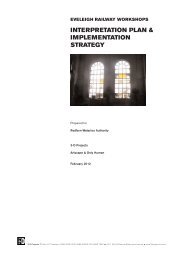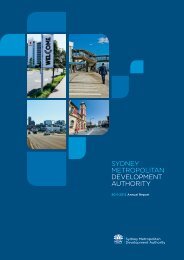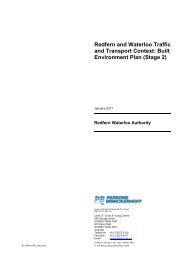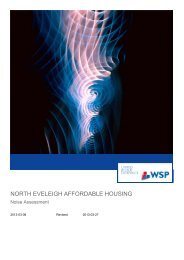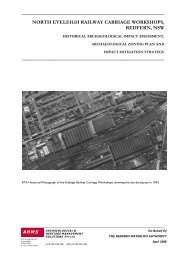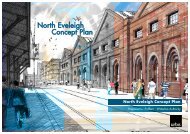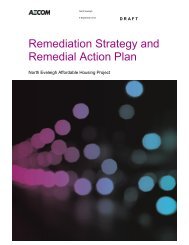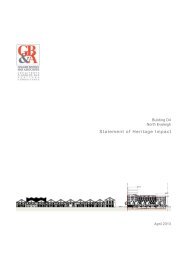Historical Archaeological Assessment - SMDA - NSW Government
Historical Archaeological Assessment - SMDA - NSW Government
Historical Archaeological Assessment - SMDA - NSW Government
You also want an ePaper? Increase the reach of your titles
YUMPU automatically turns print PDFs into web optimized ePapers that Google loves.
AECOM<br />
<strong>Historical</strong> <strong>Archaeological</strong> <strong>Assessment</strong> - The Grange - North Eveleigh Affordable<br />
Housing Project, Wilson Street, Darlington, <strong>NSW</strong><br />
14<br />
In the following two years, again, no definitive evidence is provided in the Directories regarding who, if anyone,<br />
was living in the house. In 1871 the Directory lists Thomas M’Culloch as resident of The Grange. No directory was<br />
produced in 1872 and in 1873 Andrew McCulloch is listed at The Grange. The directory for 1874 has not been<br />
digitised, but The Sydney Morning Herald records the marriage of Thomas M’Culloch, of The Grange, eldest son<br />
in 1874 (The Sydney Morning Herald 10 July 1874:6b).<br />
The lack of stability in occupancy rates may have resulted from the death of Felix Wilson on 24 September 1865<br />
(The Sydney Morning Herald 25 September 1865:1a). On his death, the property was administered by a series of<br />
trustees.<br />
From 1875 until 1884 John Little is consistently listed as the resident of The Grange in the Sands Directories. In<br />
the later years his occupation is listed as auctioneer. Rate assessment records, available online for the period<br />
1863 to 1892 (see Table 3 for a summary), confirm the Little family’s occupation between 1878 and 1883. Rate<br />
assessment records prior to 1878 cannot be conclusively tied to the property.<br />
Directories indicate that between 1892 and 1895 The Grange is occupied by William Coker. The Primary<br />
Application for the property indicates that William Coker became a trustee of the property in 1883. Sometime<br />
thereafter he appears to have married Felix Wilson’s widow, Mary Caroline Stewart Wilson, as they are listed,<br />
together with Mary’s five children, in the Primary Application in 1872 under the surname Coker. In 1896 and 1897<br />
The Grange is listed as being the residence of Mrs W. Coker, possibly indicating that William had passed away.<br />
In 1898 Sands Directories indicate the house may have been used as “The Maternity Home” of which Miss<br />
Rachel Hill was the matron. It is not possible, however, to definitively tie the listing to The Grange. In the following<br />
year there is no listing and then between 1900 and 1902 the property is listed as a private school run by Mrs M.<br />
Best. The connection between The Grange and Mrs Best’s school is confirmed by the announcement of the<br />
marriage of Mrs Best’s youngest daughter from The Grange in 1902 (The Sydney Morning Herald 25 January<br />
1902:1a). The Primary Application suggests that the property was purchased by Augusta Sophia Quigley in 1900,<br />
although it does not appear that she resided at The Grange.<br />
Between 1903 and 1905 the Sands Directories indicate the school was taken over by Miss E.C. Gray and seems<br />
to indicate she shared The Grange with William Webb and his wife, Eliza (nee Fowler). It is unclear if there is any<br />
connection between Miss Gray and the Webb’s. William and his wife seem to have wholly occupied The Grange<br />
from 1906 until 1908. In 1906 The Sydney Morning Herald reports on the golden wedding anniversary<br />
celebrations of the couple:<br />
A pleasant evening was spent on Friday evening, August 17, at The Grange, Wilson street. Newtown, in<br />
celebration of the golden wedding of Mr. and Mrs. William Webb. Many friends and relatives assembled,<br />
including children, grandchildren, and great-grandchildren. The house and grounds were tastefully decorated<br />
for the occasion, and presented a gay and animated scene. It may be interesting to note that Mrs. Webb<br />
appeared in the same wedding dress in which she became a bride 50 years ago. During the evening an<br />
adjournment was made for supper, at which the health of Mr. and Mrs. Webb was proposed and honoured.<br />
Mr. and Mrs. Webb were the recipients of many costly and valuable presents.<br />
(The Sydney Morning Herald 25 Aug 1906:11d)<br />
There are no further references to The Grange in the Sands Directories or The Sydney Morning Herald past 1908,<br />
indicating it was demolished in that year or soon after. This fits with the Certificate of Title (CT1674-19), which<br />
records the purchase of the land by the Minister for Public works in June of 1908. It seems likely that the house<br />
was demolished and the site leveled shortly thereafter.<br />
5.2.1 Physical Description and Architecture of The Grange<br />
The public submission suggested that The Grange may have been designed by John Verge, one of the earliest<br />
and the most important architect of the Greek Revival in Australia (1782-1861). This was based on the external<br />
visual similarity between an 1865 sketch of The Grange (Plate 1) and the one known photo held by the National<br />
Trust (Plate 2), and John Verge’s Rose Bay Cottage.<br />
There is no definitive evidence to suggest that The Grange was designed or built by John Verge. A search of John<br />
Verge’s surviving ledger was undertaken for the present assessment and it reveals no references to The Grange<br />
or any residence in the area which could possibly have been The Grange (Verge, 1962). The house does,<br />
however, share stylistic similarities with many of his works, as evidenced by surviving photographic and pictorial<br />
evidence of the property.<br />
24 July 2012



